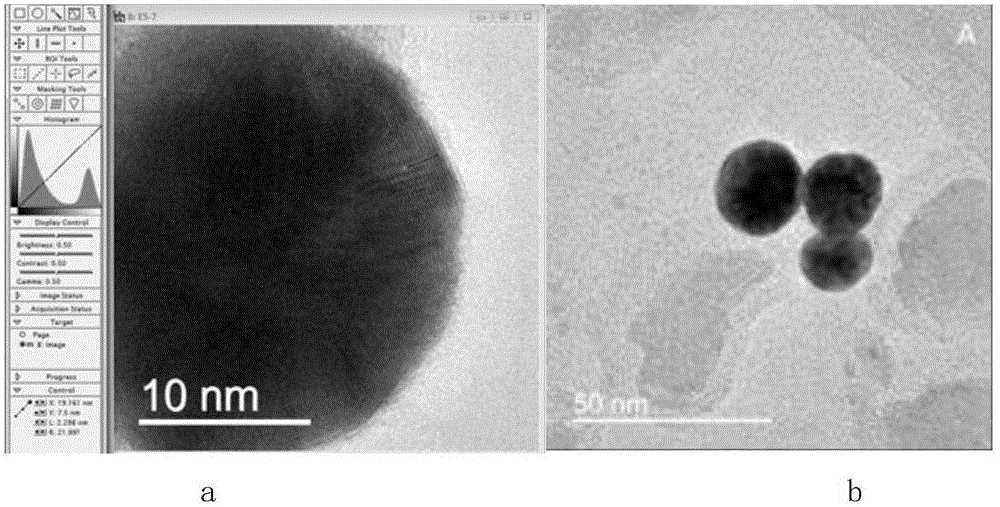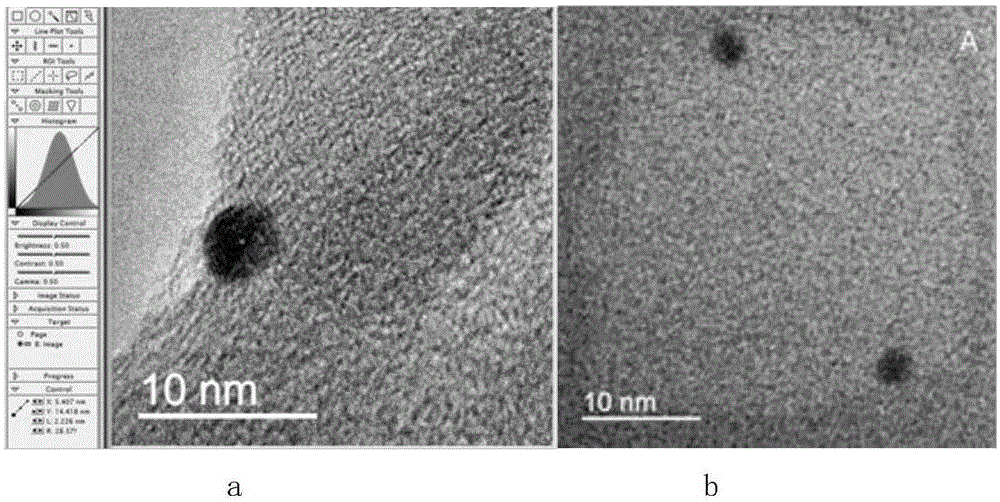Method for rapidly synthesizing nanogold quantum dot through dual reducing agent at indoor temperature
A room temperature synthesis and reducing agent technology, applied in the field of room temperature synthesis, can solve problems such as difficult control, slow reaction speed, high temperature, etc., and achieve the effect of saving time cost, saving energy cost, and reducing danger
- Summary
- Abstract
- Description
- Claims
- Application Information
AI Technical Summary
Problems solved by technology
Method used
Image
Examples
Embodiment 1
[0035] A kind of double reducing agent carries out the rapid synthesis method of nano gold quantum dot at room temperature, comprising the following steps:
[0036] 1. Prepare the solution:
[0037] Chlorauric acid (HAuCl 4 ) solution (0.05mg / mL), sodium citrate (Na 3 C 6 h 5 o 7 ) solution (5mg / mL), ascorbic acid (C 6 h 8 o 6 ) solution (5mg / mL).
[0038] 2. Experimental steps:
[0039] 21. At room temperature, add 1.0 mL of sodium citrate solution to 50 mL of chloroauric acid solution (0.05 mg / mL);
[0040] 22. Add 0.6mL of ascorbic acid solution at one time while stirring;
[0041] 23. The solution turns pink after about 2 seconds, then gradually darkens, and finally turns purple (about 2-3 seconds), indicating that the reaction is complete.
[0042] 24. Carry out high-resolution TEM analysis on the obtained product, the interplanar spacing is 0.2298 nanometers, it can be determined that it is a polycrystalline gold element ( figure 2 a), the measured crystal f...
Embodiment 2
[0044] Method is with reference to embodiment 1, but changes as follows:
[0045] 22. Change the dosage of ascorbic acid, respectively 0.4mL, 0.6mL, 1.0mL. The following table shows the statistical results of the product nanogold obtained by changing the experimental conditions.
[0046] Comparison of average particle size and particle size standard deviation of gold nanoparticles prepared under different ascorbic acid dosage conditions
[0047]
[0048] Conclusion: Other preparation conditions remain the same, when the amount of ascorbic acid increases, the particle size of gold nanoparticles increases, the reason is that the reduction speed is accelerated and the nucleation speed of nanoparticles is increased. Therefore, the particle size of gold nanoparticles can be controlled by controlling the concentration of ascorbic acid.
Embodiment 3
[0050] Method is with reference to embodiment 1, but changes as follows:
[0051] 21. Change the dosage of sodium citrate to 0.2mL, 0.5mL and 1.0mL respectively. The following table shows the statistical results of the product nanogold obtained by changing the experimental conditions.
[0052] Comparison of average particle size and particle size standard deviation of gold nanoparticles prepared under different sodium citrate dosage conditions
[0053]
[0054] Conclusion: Other experimental conditions remain the same. When the amount of sodium citrate increases, the particle size of gold nanoparticles decreases. The reason is that citrate not only acts as a reducing agent in this reaction, but also acts as a blocking agent. A protective layer is formed on the surface of the particles, which prevents further growth of the gold nanoparticles. Therefore, the particle size of gold nanoparticles can be controlled by adjusting the amount of sodium citrate.
PUM
| Property | Measurement | Unit |
|---|---|---|
| concentration | aaaaa | aaaaa |
| size | aaaaa | aaaaa |
| size | aaaaa | aaaaa |
Abstract
Description
Claims
Application Information
 Login to View More
Login to View More - R&D
- Intellectual Property
- Life Sciences
- Materials
- Tech Scout
- Unparalleled Data Quality
- Higher Quality Content
- 60% Fewer Hallucinations
Browse by: Latest US Patents, China's latest patents, Technical Efficacy Thesaurus, Application Domain, Technology Topic, Popular Technical Reports.
© 2025 PatSnap. All rights reserved.Legal|Privacy policy|Modern Slavery Act Transparency Statement|Sitemap|About US| Contact US: help@patsnap.com



